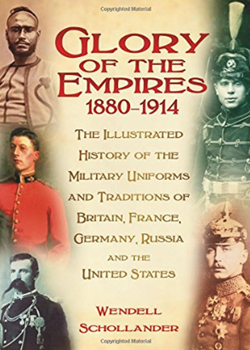Glory of the Empires 1880-1914: The illustrated History of Military Uniforms and Traditions of Britain, France Germany, Russian and the United States
- Home
- World War I Book Reviews
- Glory of the Empires 1880-1914: The illustrated History of Military Uniforms and Traditions of Britain, France Germany, Russian and the United States

By Wendell Schollander
History Press, £32.50, 896pp, ills in monochrome and colour and throughout, picture credits, bibliographies, index.
ISBN: 978-075-248-634-5
Between 1880 and 1914 officers and those in specialist army units of the great empires - Britain, France, Germany, Russia and the United States - were, truly, bedecked. Their elaborate uniforms, caps and helmets represented the last word in military finery representing centuries of regimental history and traditions – a tally of reminders of famous victories and heroic last stands.
In truth Glory of the Empires offers little about pre-1914 service dress. Instead it focuses on that of the officer classes and those in the ranks in elite military units, which form the focal point of Schollander’s research and authorship. Here we see an evaluation of the implausibility of the period’s elite military fashion, formation history and sheer ‘swank’. The result is as informative as the posing willingness of those on ‘display’ in uniforms whose utility had truly ended by 1914 - apart from modern deployment when ceremonial dress is called upon.
Above all this is a wonderful tribute to the impractical, the foppish, the over-elaborate and, by 1914, outlived military dress and skilled, ferociously costly high tailoring. The illustrations here trigger smiles, head-nods and amazement.
Clearly Wendell Schollander presents what any reviewer – with an ignorance of the subject - must be inclined to judge a definitive study of such uniforms across five empires and their colonies in India, Africa and the Philippines – and which, for the first time in my experience, exposes the reality that the USA too was once an Imperial power.
As well as reviews of the military traditions of these nations and the officers and men clothed in sartorial peculiarities – why the Russian 15th Hussars wore a mermaid pink uniform for example or the Wiltshire Regiment had dents on their buttons – the author offers much of interest about the pre-Great War armies. (Of particular fascination is the section on the Indian Army and its seemingly un-ending varieties of headwear).
The result of some 40 years of international research the book’s production quality is high, its charts clear. Regimental and specialist dress are illustrated by some 800 or so rare, black-and-white and colour illustrations.
While the books relevance to history and events of the Great War must be considered slight, it is nevertheless a fascinating and detailed overview of much that came before September 1914. I suspect those with a serious interest in military uniform will do little other than judge Glory of the Empires a (huge) delight of a book – even if it is devil to shelve!
David Filsell





